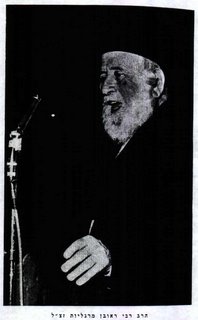Hebrew Printing in America 1735-1926 – Review II
America posed some unique questions regarding marriage and divorce laws. In the early period of American Jewish history, many people were not erudite. In an apparent effort to help with this deficiency, in 1901, R. Dov Baer Abramowitz published his Sefer Ketubah. This book contains tear out, pro forma ketubot. Thus, the Rabbi could just rip one out whenever he needed to. (No. 588). Another work which dealt with marriage issues is a small pamphlet published in 1909. This dealt with the question of a man who was induced to marry a woman who was “mentally unbalanced.” The husband was allowed to marry a second wife via a heter me’ah rabbanim (the consent of one hundred rabbis). Typically, these 100 must come from different countries, however, here, for the first time, R. Rosenfeld, the author, “explained that it could be issued by American rabbis alone because ‘at one time [the United States] were separate countries. And even today each state is, to a certain extent, [a] separate [entity].'” (No. 1144).
While on the one hand there were many in America that were in the Jewish sense, illiterate, there were also those on the opposite end of the spectrum as it was, who published scholarly works. Dr. Louis Ginzberg, published in 1909 Seriedi HaYerushalmi min HaGeizah asher b’Mitzrayim. This book contained, as the title indicates, fragments from the Cairo Genizah which enabled Ginzberg to offer correction to the standard edition of the Jerusalem Talmud. It seems that this was deemed so important even outside the U.S. As “Ginzburg’s research was included – without attribution – in the Vilna 1922 edition of the Yerushalmi” (No. 606).
This copyright infringement was actually a two way street. In 1919, The Union of Orthodox Rabbis of the United States and Canada published, for the first time in America the complete Talmud. While this signaled a new era in the Jewish learning in the US, it seems that the publishers did not secure all necessary rights before embarking on this printing. Specifically, this edition is a photo-reproduction of the Romm, Vilna edition of the Talmud. This did not go unnoticed. “Moses Rosenberg wrote to R. Hayyim Ozer Grodzinski of Vilna on behalf of the Romm publishing house. He accused Agudath Harabbonim of reproducing the Romm edition without permission and requested that Agudath Harabbonim be summoned to a rabbinical court.” (No. 635). This letter is reproduced at the end of volume II of the work. (p. 1181). The end of the second volume contains many historical letters from Yosef Goldman’s collection. Additionally, there are photographs and autographs of some famous American Rabbis as well in this last section.
On the theme of lack of religious observance, there is no lack of books dealing with this. Moses Weinberger’s book, which Sarna translated into English, “People Walk on their Heads” is but one example. R. Elijah Kochin, Sefer Aderet Eliyahu (Pittsburgh, 1917) where he complains “the city of Pittsburgh is still hefker [anarchic] and it lacks everything necessary for the highest level of observance.” He decried the “accepted evil custom in this land which says that he who lies the most by bluffing, as it is called, is to be praised.” (No. 784).
Already in 1872, Nahum Streisand who I have no idea if any relation to the now woman singer Barbara, which would be rather ironic in light of the fact this book “contains an analysis of the rabbinic debate over the prohibition for a man to hear a woman singing. Streisand had originally sent its contents to Henry Vidaver after the latter issued a ruling permitting women to sing in the choir of his congregation, Bnai Jeshurun.” (No. 1091).
Other issues which came up include metzizha b’peh and whether one can use a sponge. See nos. 1117. In 1915 a book on circumcision was published which, in part dealt with metzizah b’peh by the milah board. This board was “recognized by the New York City Commissioner of Health . . . [who said] the educational value of such work as the Milah Board has done in this matter is of the greatest help to the City, and particularly to our department.” (No. 1158).
Another issue was the use of wine during Prohibition. Dr. Louis Ginzburg published a responsa which argued that grape juice was sufficient for ritual that would otherwise require wine. He did this as “during the era of Prohibition, the government granted special licenses allowing the sale for sacramental purposes. Some Jews abused these licenses.” Ginzburg, wanted to void the use of wine, thus obviating the need for such licenses. This responsa “elicited enough interest in the secular world to merit a press conference and coverage in a major newspaper [i.e. the New York Times].” (no. 1177).
This was not the only work influenced by Prohibition. Isidore Koplowitz published “Midrashic Exegetics on Wine and Strong Drink.” He endeavored to prove “that the Hebrew prophets and a host of Talmudic Rabbins, were outspoken in the great cause of prohibition.” No. 1179.
